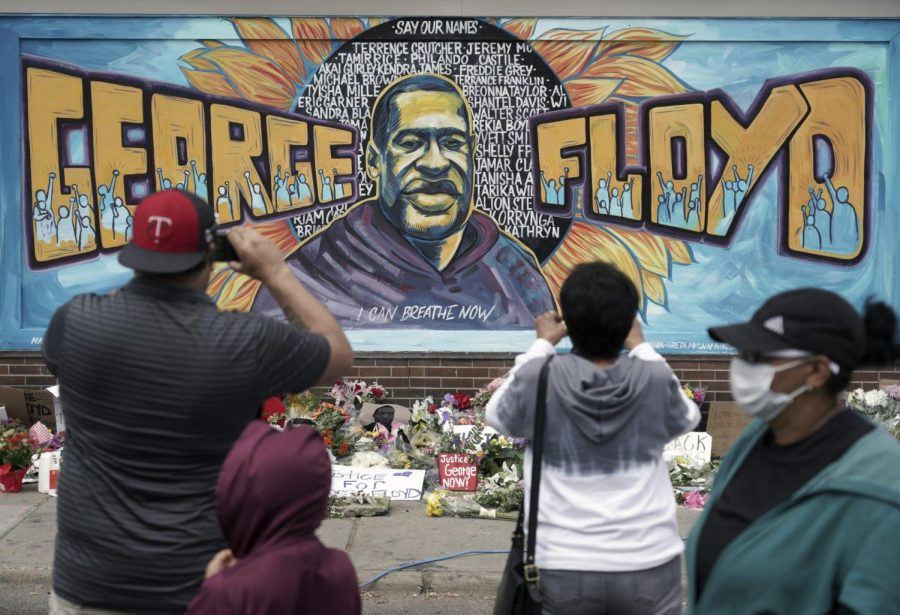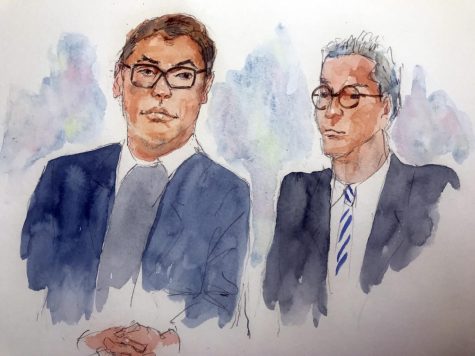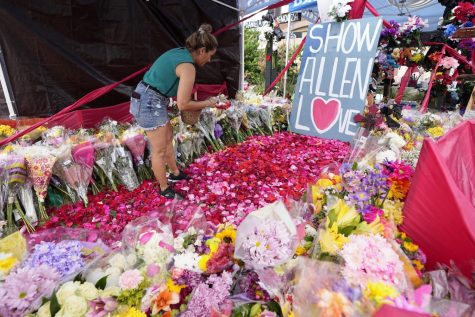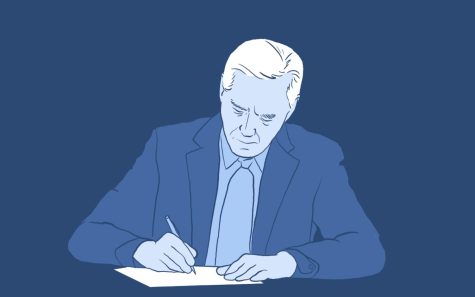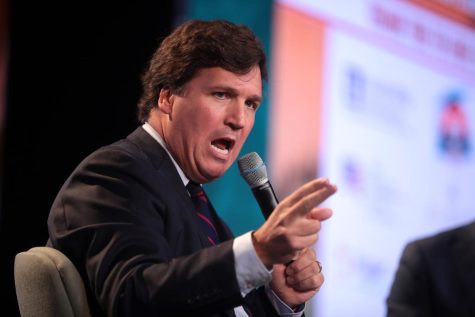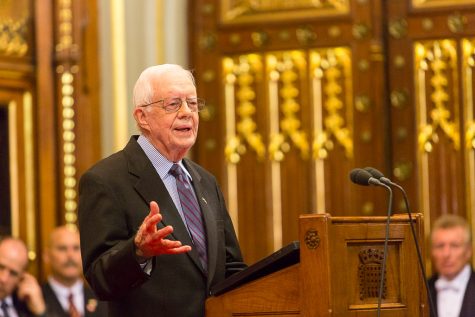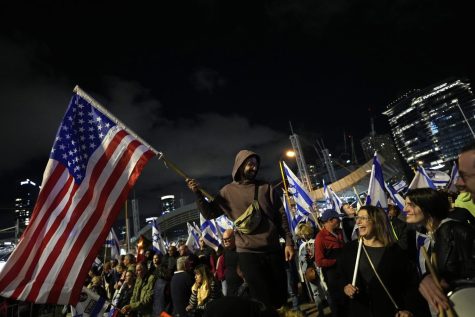Killing of George Floyd ignites nationwide unrest
Brian Peterson/Star Tribune via AP
People gather on Friday May 29 at a memorial mural painted outside the Cup Foods store on Chicago Avenue in South Minneapolis where George Floyd died at the hands of police.
MINNEAPOLIS — Last night a crowd outside Minneapolis Police’s 3rd Precinct chanting a chorus of “Whose streets? Our streets!” echoed as flames coming from within the police headquarters licked the night sky as the building slowly burned.
What began as a call about suspected forgery on a grocery store check ended in the death of 46-year-old George Floyd, who died in police custody Monday night in Minneapolis, turned into a string of gradually intensifying protests, culminating in protestors taking over the precinct and setting it ablaze.
Minneapolis native Destiny Mans was at the scene where she endured waves of tear gas in her eyes. Still, she felt she needed to be there.
“Why wouldn’t it be worth it? You expect it and brace for it. When you people go unheard for so long, you are outraged and how do you expect rage to be logical?” Mans said. “We have to be loud because for so long they’ve refused to listen to us.”
On Wednesday night, the nearby Autozone was set ablaze and other local businesses broken into. The next morning, Minneopolitans helped clean up the glass, rubble and ash left behind. Hundreds of people simultaneously protested and cleaned on Thursday, both actions creating a spirit of community support in the South Minneapolis neighborhood.
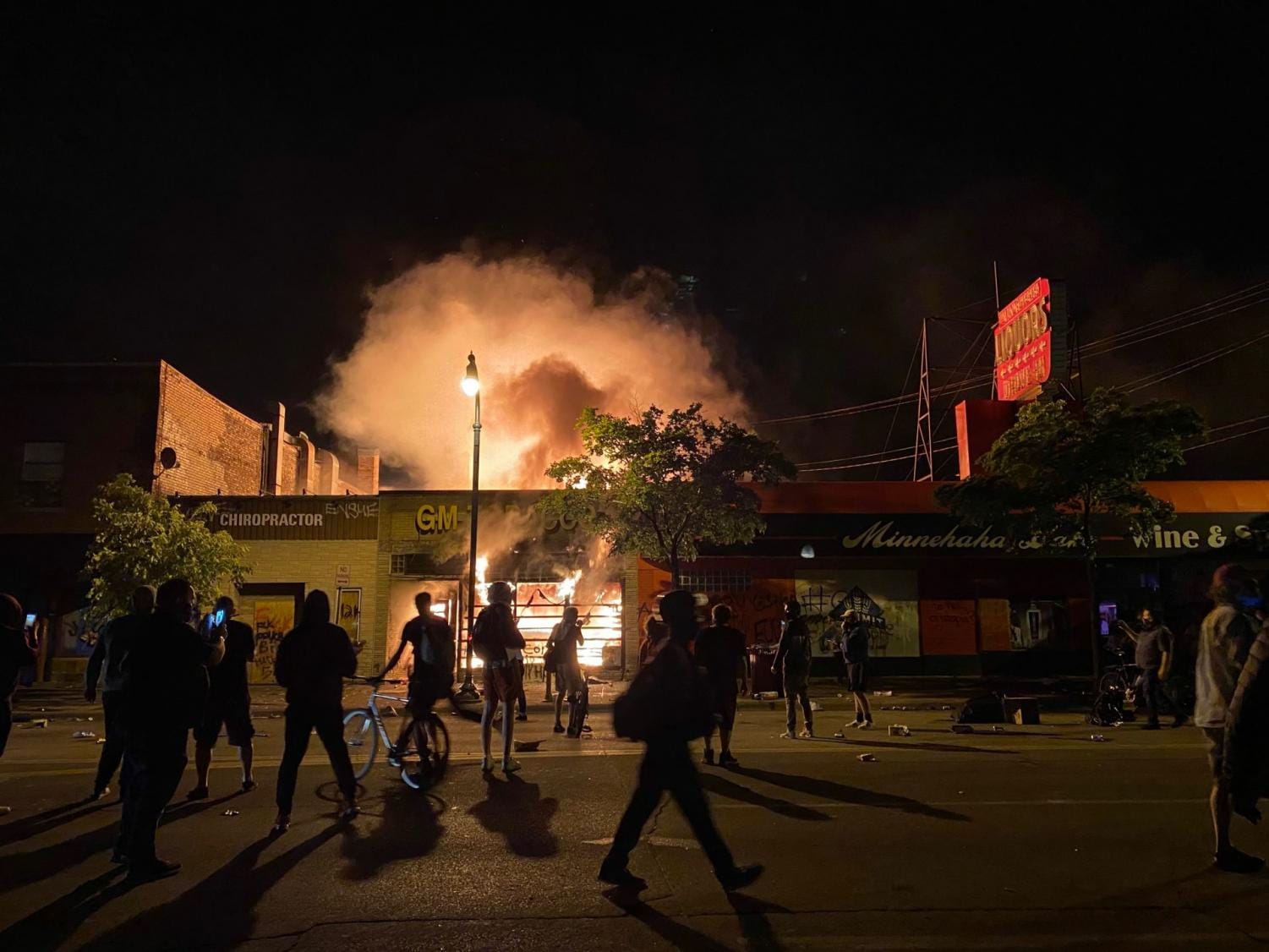
Monica Moore lived in Minneapolis for 10 years. She said she’s proud of her community.
“I see a community of people that’s tired of the same stuff that goes on,” Moore said. “Somebody always gets off. It’s always some reason why they’re excused from murdering somebody that didn’t deserve to be murdered.”
As night fell on Thursday, the only illumination on the hundreds of people around the blocks of East Lake Street and Minnehaha Avenue came from bursts of fireworks and the multiple fires set to buildings nearby. The demonstrators cheered as a group of them got past the fence surrounding the precinct, which had been evacuated earlier according to Mayor Jacob Frey.
The masks that most of the crowd had on as protection against the spread of COVID-19 doubled as deterrents from smoke and gas entering their lungs.
Floyd’s death initially made national news Monday when a bystander’s video was posted to social media. The nearly 10-minute video shows a handcuffed Floyd repeatedly saying “I can’t breathe,” as Minneapolis police officer Derek Chauvin pins him down to the concrete with his knee pressed into Floyd’s neck for nearly eight minutes — while fellow officers Thomas Lane and J. Alexander Kueng held down the rest of his body and Tou Thao stood nearby.
“Being Black in America should not be a death sentence,” said Frey in a statement posted to Facebook following the incident.
Frey acted swiftly — immediately condemning the officers’ actions and calling for their arrests.
All four officers were fired by Minneapolis Police Chief Medaria Arradondo the day following Floyd’s death.
Chauvin was taken into custody Friday afternoon, according to Hennepin County Attorney Mike Freeman, and charged with third-degree murder and manslaughter, “after the office gathered enough evidence to prove the case beyond a reasonable doubt.”
Demetrius Jordan, an adjunct faculty member at DePaul who worked for 20 years at a federally-contracted halfway house, said that police were instituted to target black people.
“Police were actually slave-catchers,” Jordan said. “The historical connection between police and African-Americans in this country is already taught with friction just because of its start.”
Officers abuse their power by not avoiding violence and aggression, Jordan explained.
“You never create a barrier between the person being restrained, yourself and the ground,” he said. “If you pin someone on the ground, they will die.”
Tiana Towns protested in downtown Minneapolis during a march through the city Thursday evening. She echo’s Jordan’s sentiment.
“It was almost like the cop was flexing for the camera,” Towns said. “It’s unacceptable and at some point we have to draw a line somewhere and say that black lives do matter but also please conduct matters.”
Chauvin was not the only one involved in the killing of Floyd.
“If you see the video from the angle, you see there are three officers who are holding this man down,” Jordan said. “That’s just ‘we’re police and we’re doing our job. This is just normal that we treat a human like this.’”
After the officers identities were confirmed, it was discovered that Chauvin and Floyd worked “overlapped” security shifts together at El Nuevo Rodeo Club up until the end of last year, per KSTP-TV.
Towns thinks many people have a misconception that Minneapolis is a bastion for liberalism and progressive values and that the incident highlights the double standards that do exist in the city, disparities in education, homeownership and wealth.
“At the end of the day, racism is pervasive. Let’s not keep putting our head in the sand as Minnesotans,” Towns said. “It’s still racism okay, there still needs to be an institutional change.”
Not only does Chauvin have a history with Floyd, he also has a history of excessive force.
Eighteen complaints have been filed against Chauvin prior to Floyd’s death in his 19-year career with the Minneapolis Police Department. He faced no disciplinary action beyond two letters of reprimand and paid leave following the fatal 2006 police-involved shooting of Wayne Reyes.
Thao has six prior complaints and was also part of a 2017 excessive force lawsuit. The other two officers have no prior complaints against them.
Jordan encourages people to continue posting and spreading information through social media.
“I’m one to believe that when you openly and honestly put out there for the world your belief, it forces people to do one of two things,” he said. “To force a conversation if they’re intelligent enough to speak with you about differences in beliefs, or it forces you [them] to be an outlier to the rest of the society and that diminishes your [their] power.”
Media coverage of the protests are typically curated for monetary purposes.
“The media exposés of the protestors in Minnesota are violent, but the protestors who stormed the state house in Michigan when it was AR-15s and machine guns, are just patrons,” Jordan said.
Although armed protestors who gathered across the country to demand an end to the coronavirus lockdown were met with no force by police just weeks ago, police sprayed those protesting Floyd’s death with tear gas and shot them with rubber bullets.
Minnesota Gov. Tim Walz declared a state of emergency and called in the National Guard, as more protests are set to continue through the end of the week.
President Trump chimed in on the protests in tweets referring to protesters as “thugs” and calling for the National Guard to implore violence to regain control, writing “when the looting starts, the shooting starts.”
Twitter has since flagged the tweet as violating their rules about glorifying violence. The tweet directly quotes former Miami Police Chief Walter Headley during a December 1967 news conference. In the years since, the comments have been cited as a contributing factor in rioting that broke out in the mostly black Liberty City section of Miami the following summer, according to The Washington Post.
Protests also broke out across the nation — including in Memphis, Los Angeles, New York City and Chicago. Chicago Police Department Superintendent David Brown condemned the actions of the officers in a Thursday afternoon statement.
“I have ordered mandatory training on positional asphyxiation to be completed by every officer throughout the department by the end of each tour today,” Brown said. “I have also required officers to view the video of the incident.”
The Department of Justice and FBI have launched investigations into Floyd’s death, which are to be expedited at the request of President Trump.
Freeman, the prosecutor in charge of the case, defended the initial delay in charges three days after Floyd’s death in a news conference.
“That video is graphic and horrific and terrible, and no person should do that,” he said. “But my job, in the end, is to prove that he violated a criminal statute, and there is other evidence that does not support a criminal charge.”
Freeman also compared the case to the 2015 death of Freddie Grey while in Baltimore police custody, in which the six officers involved were charged 12 days after Grey’s death but were ultimately acquitted, as reasons not to “rush to charge” in Floyd’s case.
Baltimore City State’s Attorney Marilyn Mosby responded to the comparison calling Freeman’s use of Grey’s case to justify inaction “shameful” and cited the video as reason enough to bring charges against the officers involved.
“I didn’t have video footage of a murder — evidence any prosecutor would dream of,” Mosby said. “Mr. Freeman needs to own his decisions and be courageous enough to decide whether or not to prosecute and pursue justice for the murder of George Floyd.”
For Jordan, the expected outcome for justice looks different from the potential outcome.
“Unfortunately, my expected outcome is a compromise,” he said. “Like, ‘okay, they’ll go to jail, they’ll go to prison, but we can’t send them there for life, or we’ll charge and arrest the one, but maybe not the three.’”
Ultimately, Jordan believes the federal decision will still be an injustice to Black Americans.
“That hurts. Why can’t it just be judged on the face of his merits?”


